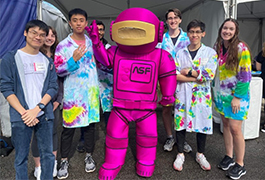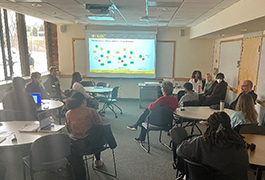Techniques for Mediating Conflict in Your Student Chapter
Last updated 8/31/2021

As a leader of an ACS student chapter, you probably felt excited and, hopefully, prepared to take on the responsibility of your role. Planning events and hosting chapter business meetings are roles that likely came with a list of responsibilities for your position. One role you might not have expected to fulfill is that of a conflict mediator.
In almost every group, conflicts are bound to arise as people disagree over how to tackle a given problem or task. These disagreements can be exacerbated by differences in personality and communication styles, and they can be difficult to overcome. As a leader, you might have to step in to help your members find a resolution to a problem in order to keep the chapter on track for success.
As an example, let’s say your chapter is planning an outreach event for Chemists Celebrate Earth Week (CCEW), and the two heads of your outreach team, Nadia and Matt, are not getting along. Nadia is fairly free-spirited and prefers to communicate face-to-face or using the group text. She wants to think outside the box this year and move beyond her chapter’s traditional Tree Planting Day. She proposes doing a green chemistry demo at a local school. Matt, in contrast, likes traditional activities and prefers to communicate official ideas in e-mail so that he has a record. He is a bit shy and likes the idea of continuing to plant trees on campus, perhaps even extending it to a cleanup of the nearby river as well. Matt feels like Nadia is being pushy with her idea, and Nadia feels that Matt is unfairly shooting down her proposal.
When to step in?
This is perhaps the hardest question to answer because it is based on a unique set of circumstances for each chapter. Conflicts can often trigger a “fight-or-flight” response in people, ranging from loud arguments to passive–aggressive actions to avoidance. As a leader, it’s probably best to step in when the approaches to resolving issues are not working, or, at least, when one party indicates they are having difficulty working with another party.
In our example, the situation escalates when Matt finds out that Nadia has, without consulting with him first, announced to the rest of the outreach team that the chapter will be doing green chemistry demos. Upset with Nadia, Matt has come to you, the chapter leader, to air his grievance.
How to respond?
If someone comes forward with a concern, you should make sure they feel heard and understood while remaining impartial. It’s often best to offer advice one-on-one first without jumping straight into mediation. If that fails, or if you’re coming up on a deadline for planning an event with still no possibility of a resolution, it’s probably time for mediation.
When Matt comes forward to you with the issue, you should acknowledge his frustration and ask what he thinks would help solve the problem. While mediation is usually the last thing people want to do, it is often a more successful method for resolving future problems than having chapter members speak through you indefinitely. So although Matt may indicate he wants you to talk to Nadia on his behalf, it may still be best to sit down with both of them to help them discuss how to work through this issue together.
Starting a mediation
Setting up mediation can feel extremely awkward, especially if one party doesn’t realize there is a problem, which, unfortunately, does happen. If possible, talk to both parties one-on-one and in person, and let them know you’d like to have a meeting to discuss the issue at hand. Avoid blaming either party; instead, offer your help in finding a resolution.
Meet in a place where everyone feels comfortable, like a club room if you have one, or a quiet corner of campus. Ideally, everyone should be sitting at the same height, so that no one feels like they are being overpowered.
Setting up ground rules
Once everyone has assembled together, it’s time to set up some ground rules for the discussion. Although they may not need to be strictly enforced, if the conversation gets heated, it’s good to have these rules of engagement set up to refer back to later.
Good rules to include are:
- Use active listening techniques
- Give each speaker your full attention during the discussion (as the leader, set a physical example by leaning in when a person is talking)
- Take turns during the conversation
- Have the parties address each other, not you
Your primary purpose is to observe and, if needed, enforce ground rules. While you can offer neutral suggestions to solve a problem, ultimately the parties involved need to work out a solution that will work for them going forward. Encourage people to use “I” statements in describing the problems, such as “I feel…” and “I would like to…”. Such statements tend to come off as less aggressive and can help each person understand how their actions affect others. More ground rules concerning respect and openness to finding a compromise can also be added, if appropriate.
Mediation and follow-up
In the CCEW scenario, Nadia and Matt were having problems on many fronts, including personality and communication differences stemming from the surface issue of which type of event to host. Addressing the surface problem is like trying to put a Band-Aid on a bullet hole (yes, that’s a Taylor Swift reference). If the issues underneath aren’t resolved, then there’s the potential for future misunderstandings and conflicts.
Encourage each person to explain why they feel the way they do about the problem. Matt might indicate he doesn’t feel comfortable speaking up over Nadia, and she, in turn, might feel like he doesn’t take her ideas seriously. Ask each of them how they would propose finding a solution, and have them talk it out until there’s an agreeable compromise.
A possible resolution for this conflict might include Nadia and Matt agreeing in writing rather than in person before announcing plans for an event. Matt could forgo tradition but still be able to give input by helping to fully flesh out Nadia’s idea. Of course, there are many ways this scenario could play out. The key is to have both parties agree on a compromise in such a way that they both feel satisfied that they’ve been heard.
If you achieve compromise and good communication, consider the mediation successful. If the conflict has been especially contentious, it’s a good idea to write up a “contract” of sorts, with each party outlining what they agreed to so they can reference their plan if they need it in the future.
Mediating conflicts can feel uncomfortable, but leaving them to fester can be destructive to the health of your chapter and may discourage others from wanting to work on projects together. By impartially approaching conflicts in your chapter, you can help make your chapter a successful and thriving place where people are happy to share their love of chemistry.





